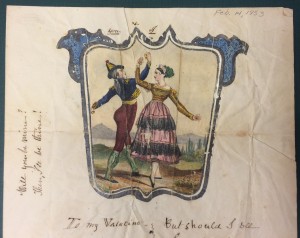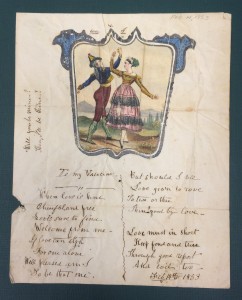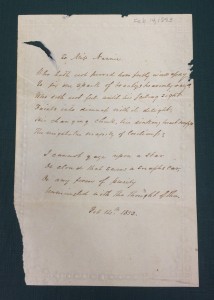Before superhero and princess Valentine’s Day cards, we had Lord Byron.
 Detail, 1853 Valentine's Day letter.
Detail, 1853 Valentine's Day letter.
Although commercially produced Valentine’s Day cards were becoming popular in America by the mid-1850s, at least one family in Williamsburg, Virginia still favored the older practice of hand-writing letters on February 14.
Nestled amid the personal papers of the Galt family is this pair of valentines from 1853. The Galt Family Papers (I), 1745-1892 contains primarily medical papers, including apothecary shop daybooks, and various notebooks and account books related to the Galt family’s work at Eastern State Hospital. The personal papers consist of diaries, letters, scrapbooks, memoirs, and school notes.
The valentine letters pictured here, dated February 14, 1853, quote excerpts of poetry by Lord Byron (1788-1824) and Thomas Moore (1779-1852). The authors of these valentines both neglected to attribute the poetry, suggesting that these were well-known verses—or, at least, were verses known to the recipient.
 1853 Valentine's Day letter with poetry by Thomas Moore
1853 Valentine's Day letter with poetry by Thomas Moore
The first letter (right) is neither addressed nor signed. At the top appears a colorful illustration of a young couple dancing, attired in romanticized costume. This illustration is pasted onto the paper and the words “you and I” are written above it. The poem, by Thomas Moore, is addressed “To my Valentine”:
When love is kind
Cheerful and free
Love’s sure to find
Welcome from me…
The second valentine (below, right) is addressed “To Miss Fannie,” but is also not signed. The first verse is an excerpt from Byron’s heroic poem, The Bride of Abydos (1813):
 1853 Valentine's Day letter with poetry by Lord Byron
1853 Valentine's Day letter with poetry by Lord Byron
Who hath not proved how feebly words essay
To fix one spark of Beauty’s heavenly ray?
Who doth not feel, until his failing sight
Faints into dimness with its own delight,
His changing cheek, his sinking heart confess
The might – the majesty of Loveliness?
The second verse may be original poetry by the letter’s author:
I cannot gaze upon a star
Or cloud that seems a seraphs car,
Or any form of purity
Intermingled with the thought of thee.
Together, these valentines reveal an intimate glimpse into mid-nineteenth-century Valentine’s Day customs, as well as illustrate a means through which poetry was once circulated among readers.
Galt Papers (I), 1745-1892
Mss. 78 G13